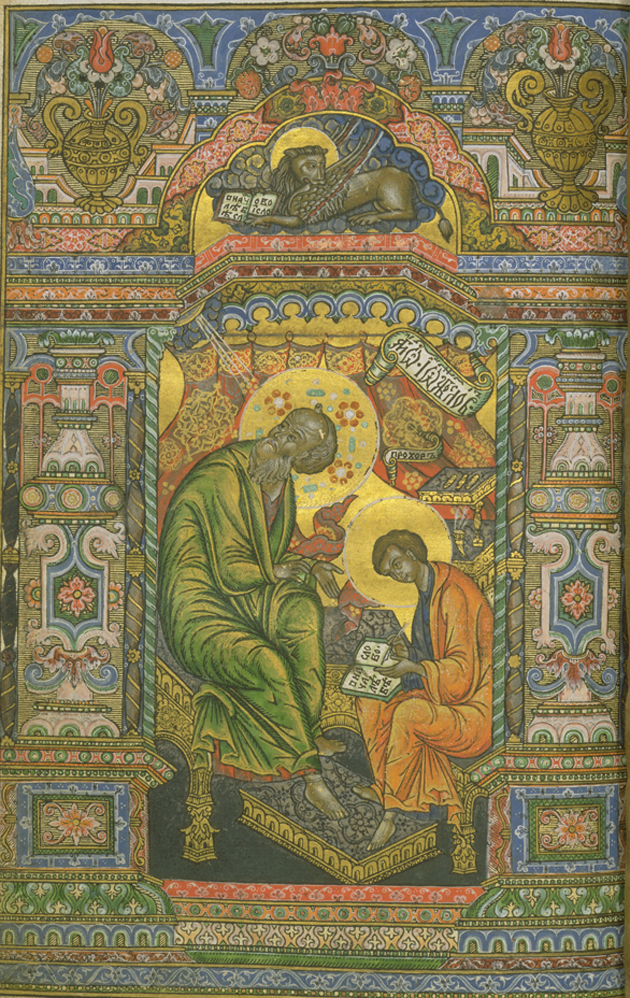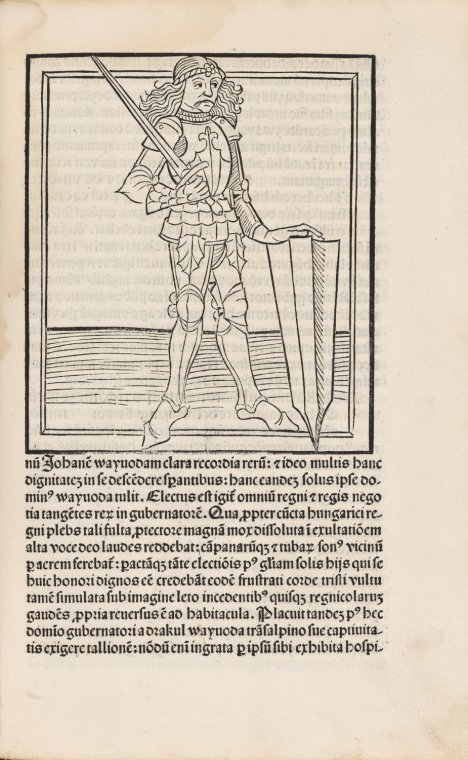Old Printed Books
The New York Public Library holds over 2,000 titles in vernacular Slavic and East European languages and works in other languages printed on territories traditionally populated by Slavic and East European peoples before 1825. The two oldest titles in this diverse collection were printed in 1488. János Thuróczy/Thuróczi (1435?–1489?) was a Hungarian historian who wrote Chronica Hungarorum. It was published in Brünn (present-day Brno, Czechia) by Conrad Stahel and Mathias Preunlein on 20 March 1488. The first full Bible in Czech was printed in the Severýn establishment in Prague by Jan Kamp on 1 August 1488. It is the oldest printed translation of the Bible into any Slavic or East European language. It follows the version revised by Jan Hus (1369-1415) and his followers, especially Martin Lupáč (d. 1468). Schweipolt Fiol (1460? -1526), the first printer of Cyrillic books, is represented in the collection by his Triod tsvetnaia [Pentecostal Liturgy] which appeared in Cracow in 1493. Among the works by other early Slavic printers, there is a psalter Iže v Tr[o]ici slavimi B[og]... published in Venice in 1537 by Božidar Vuković (1460-1539), one of the first printers of Serbian books. The library also holds Leitourgikon Izhe v s[v︠i︡a]tykh ō[t]︠t︡sa nashego Vasili︠i︡a Velikago pouchenie (1554) which was printed by Vuković's son Vićentije "Vićenco" Vuković in his printing shop in Venice,. At the time, it was the greatest and the most prolific press among the South Slavs.
Antun Dalmatin and Stipan Konzul prepared the first printed translation of the New Testament into Croatian. It was printed in Tübingen in Glagolitic script in 1561/62 with parallel text in German under the title Der erst[-ander] halb Theil des newen Testaments. The library also holds the first Croatian grammar written by Bartholomaeo Cassio/Bartol Kašić (1575-1650) and published as Institutionum linguae Illyricae libri duo (1604).
The oldest Polish edition of the Bible in the collection is Bjblia swięta also known as Brest Bible printed by Bernard Wojewódka (d. 1554) in 1563. The library holds more than 500 old printed Polonica published from the fifteenth through the 1eighteenth centuries. Among the works documented are many early sixteenth-century editions published in Cracow printing shops of Jan Haller (Thoma Aquinas, Thomas de ente et essentia vna cū tractatulo suo in calce annexo De natura accidentis, 1506), Florian Ungler (Jan Stobnica, Jntroductio in Ptholomei Co[s]mo- /graphiã..., 1512), Marek Szarffenberg, and Hieronim Wietor (Jodocus Ludovicus Decius, Diarii Et Earvm Qvæ Memo- / ratu digna in [s]plendidi[ss]imis, 1518), a well as seven of the latter's Viennese imprints. There is also a panegyric by a famous Polish poet Jan Kochanowski, Iezda do Moskwy, 1583 (also digitized) dedicated to the war achievements of Krzysztof Mikołaj Radziwiłł (1547-1603), nicknamed "Piorun" (The Thunderbolt) in the fight against Russia in 1581.
 The works of Ivan Fedorov (1510-1583) who holds the distinction of the first Russian printer are represented by his Nachasha pechatati... also known as Apostol [The Acts of the Apostles] which appeared in 1564. After he left Moscow Fedorov produced another edition of Apostol which appeared in L'viv, Polish-Lithuanin Commonwealth (present-day Ukraine) in 1574, and the Ostroh Biblia (1581). Piotr Mstislavets was Fedorov's associate who eventually opened his print shop in Vilnius, Polish-Lithuanin Commonwealth (present-day Lithuania) where among other titles he published I ach̨ekh siiu s[via]tuiu knigu [The Four Gospels] (1575). Jurij Dalmatin's early translation of the Bible into Slovenian (Biblia, Tv Ie, Vse Svetv Pismv..., 1584) set the literary norm for this language. Very rare outside of Russia Tetro Ėv[ang]alie ...[The Gospels] published by Anisim Mikhailovich Radishevskii in Moscow in 1606 is noteworthy for its hand-colored ornaments and miniatures (shown to the right).
The works of Ivan Fedorov (1510-1583) who holds the distinction of the first Russian printer are represented by his Nachasha pechatati... also known as Apostol [The Acts of the Apostles] which appeared in 1564. After he left Moscow Fedorov produced another edition of Apostol which appeared in L'viv, Polish-Lithuanin Commonwealth (present-day Ukraine) in 1574, and the Ostroh Biblia (1581). Piotr Mstislavets was Fedorov's associate who eventually opened his print shop in Vilnius, Polish-Lithuanin Commonwealth (present-day Lithuania) where among other titles he published I ach̨ekh siiu s[via]tuiu knigu [The Four Gospels] (1575). Jurij Dalmatin's early translation of the Bible into Slovenian (Biblia, Tv Ie, Vse Svetv Pismv..., 1584) set the literary norm for this language. Very rare outside of Russia Tetro Ėv[ang]alie ...[The Gospels] published by Anisim Mikhailovich Radishevskii in Moscow in 1606 is noteworthy for its hand-colored ornaments and miniatures (shown to the right).
Published in 1581 in Kralice, Kingdom of Bohemia, Pjsně Duchownj Ewangelistské is a collection of 744 hymns, with melodies for the Moravian Brethren that is decorated with numerous woodcuts, comprising two pictorial title borders, portraits of King David and Jan Hus and many ornamental and historiated borders and initials. Among the early printed books from Ukraine, there is Bozhestvenye liturgie [Litourgikon] which was printed in 1620 at the Kyiviian Cave Monastery from which the Library has several other books including a beautifully illustrated 1669 edition of the sermons of Innokentii Gizel' entitled Mir s B[o]gom ch[e]loveku [Peace of Man with God].
A breviary by Šime Budinić (1535-1600) published in 1635 in Rome under the title Ispravnin za erei ispovidnici i za pokornik.. is an example of a publication written in Glagolitic script, that is the oldest known Slavic alphabet. The first edition of the digest of canon law by which the Russian Orthodox Church was guided was published in 1600 but soon after most copies were barred from circulation and a revision of the work was ordered by Patriarch Nikon (1605-1681). Some folios were removed, others added, some were reset and the work was reissued in 1653 as Nachata zhe bystʹ pechatati sį̄e B[o]go[v]dokhnovennąe kniga Kormchąe. It remained in use well into the nineteenth century.
The 1647 Russian translation of Johann Jacobi von Wallhausen’s infantry manual which appeared as Uchenie i khitrost'... is the early example of a non-ecclesiastical book very few of which appeared in Russia before the reign of Peter the Great. There is also a 1653 edition of Pamvo Berynda’s Leksikon published at the Kuteino Monastery in present-day Belarus'. A translation of work by Johann Hübners Kurtz Fragen aus der neuen und alten Geographie was published in Russia in 1719 as Zemnovodnago kruga kratkoe opisanie.
The library also has the first Bible in Latvian: Ta Swehta Grahmata (1689). One of the earliest Bulgarian Cyrillic imprints, the 1806 edition of Kẏrīakōdromīō[n] [Book for Sundays] by Saint Sophronius of Vratsa (1739-1813) is present in the collection. The library also holds a rare copy of the Church Slavonic translation of Konstantinos Byzantios the Protopsaltes' Typikon Ekklesiastikon which appeared as Typik tesrkovnyi (1853).
Johann Amos Comenius (1592-1670), a Moravian philosopher, pedagogue, and theologian is considered the father of modern education. The Library holds several of his works inlcudling I. A. Comenii Ianva avrea reserata qvatvor lingvarvm..., 1640; J.A. Comenii Janua linguarum reserata..., 1644; Joh. Amos Comeni Eerste deel der School-geleertheyd..., 1673, and Joh. Amos Commenii Orbis sensualium pictus quadrilinguis... (1679). The latter is an early edition of the first picture book for children originally published in 1658.
Some early printed books in the NYPL collection contain inscriptions which are important sources for reconstructing the history of the books’ ownership and dissemination. There are also books with fine bindings and other distinguishing features. Some old printed books have been digitized including a prayer book Molitvoslov published in 1776 at the Pochaev Monastery in what is today Ukraine as well as a Greek translation by Meletios Syrigos of the much-debated text by Metropolitan Petro Mohyla Orthodoxa confessio Catholicae atque Apostolicae Ecclesiae Orientalis (1645) which was published in 1751 as Orthodoxos homologia tēs Katholikēs kai Apostolikēs Ekklēsias tēs Anatolikēs with the original Latin text in parallel columns and German version at foot of the page.
One should also mention numerous books that deal with Slavic and East European topics but were published outside of the region. For example, an interesting source for the history of the South Slavic lands in the sixteenth century is Bartlomej Dordevic's De afflictione Tam Captivorvm quàm etiam sub Turcæ tributo viuentium Christianorum, cum figuris res clarè exprimentibus (Antwerp, 1544). Respublica, siue status regni Poloniæ, Lituaniæ, Prussiæ, Livoniæ, etc. diuersorum autorum. (Amsterdam, 1627) includes selections from Martinus Cromerus, Alex. Gugnini, Philippus Honorius ([pseud.], Thuanus, Joannes Boterus, Joannes Lasicius, Joannes Barclaius, and others. Historia delle guerre civili di Polonia divisa in cinque libri progressi dell'armi Moscovite contro Polacchi (Venetia, 1671) was written by Alberto Vimina, an Italian adventurer, priest, diplomat, and travel writer. An illustrated copy of the major Polish hagiographic work, Philosophia sacra, sive Vita divi Stanislai Kostka was published in 1715 in Dillingen, Swabia. It carries engravings by Johann Ulrich Kraus (1655–1719), an early German illustrator, engraver and publisher.
Bibliography
- Berlstein, Alfred. "Three Old Polonica in The New York Public Library," Polish Review 3(7) (February 15, 1943): 8-9.
- Czapnik, Marianna. "Rare Polonica in The New York Public Library: Books of the Fifteenth–Eighteenth Centuries: Introduction", Slavic & East European Information Resources 9:4 (2008): 391-401.
- ----------. ed. based on materials compiled by Robert H. Davis, Jr., Rare Polonica in the New York Public Library: Books of the 15th-18th Centuries (New York: Norman Ross Pub., 2001).
- Davis, Robert. H. "Cyrillic Old Slavonic, Imperial Russian and post-Revolutionary manuscripts and printed books in the Spencer Collection, the New York Public Library: A Brief Chronological Overview", INSPEL 26:4 (1992): 254-270.
- Isaievych, Ia.D. “Two Rare Russian Books in the Collections of the New York Public Library”, Solanus n.s. 4 (1990): 76-86 [The text is about Tetro Ėv[ang]alie (1605) and Chasovnik (1630)].
- Mathiesen, Robert. "Church Slavonic Books in The New York Public Library: A Preliminary Catalogue", Bulletin of Research in the Humanities 87:4 (1986/1987): 404-417. [In HathiTrust]
- Old (pre-1860) Slavica in the NYPL: a preliminary catalog, [v. 1] Pre-1860 Slavica in Slavonic and Mss Divisions. Short title catalog / R.C. Mathiesen. -- [v. 2] Pre-1860 Slavica in the Main stack collections -- Suppl. 1. Analytics. (1996)
- Pozdeeva, Irina V. and Zora Z. Kipel. Church Slavonic, Glagolitic, and Petrine Civil Script Printed Books in the New York Public Library: A Preliminary Catalog (Marina del Rey, Calif.: Charles Schlacks, c1996).
- Terzopoulos, Konstantinos. "Some notes on the Slavic translation of Konstantinos Byzantios’ Typikon Ekklesiastikon of the Great Church of Christ,” Θεολογία 75.2 (July-Dec. 2004): 495-527. [Deals with Typik tserkovnyi]
![Mirʺ sʺ B[o]gomʺ ch[e]lovĕkū](https://libapps.s3.amazonaws.com/accounts/173701/images/nypl.digitalcollections.07f6f990-169b-013b-bd11-0242ac110002.005.w.jpg)


